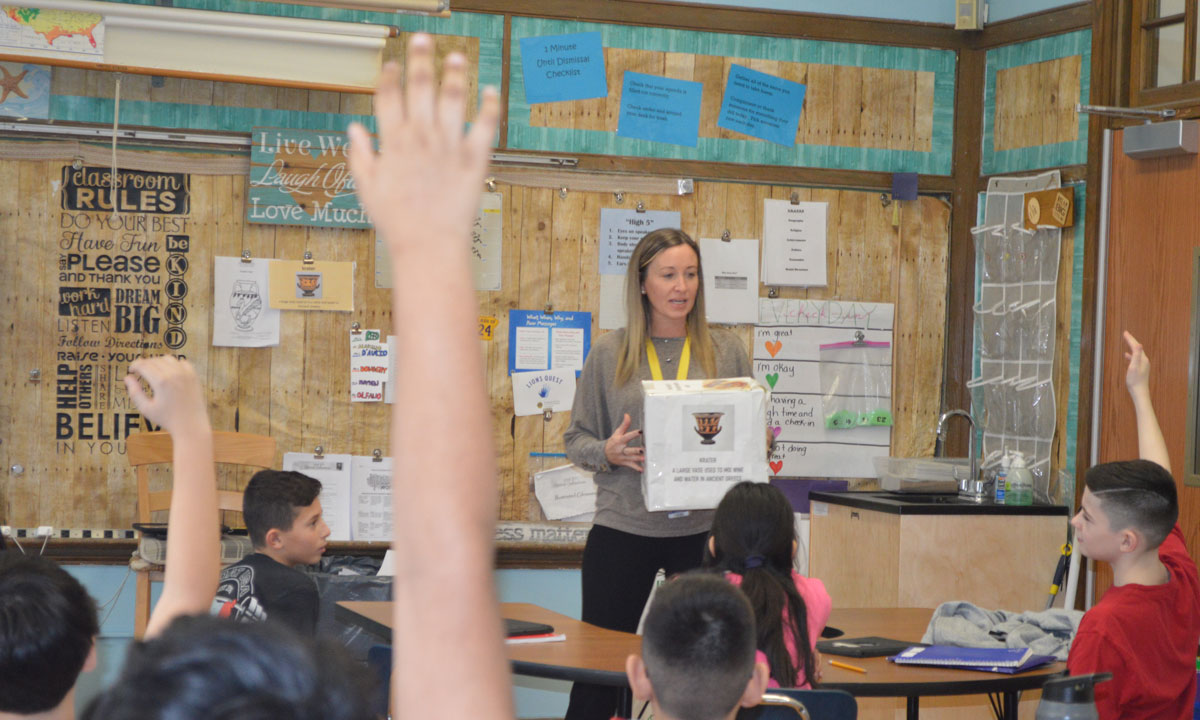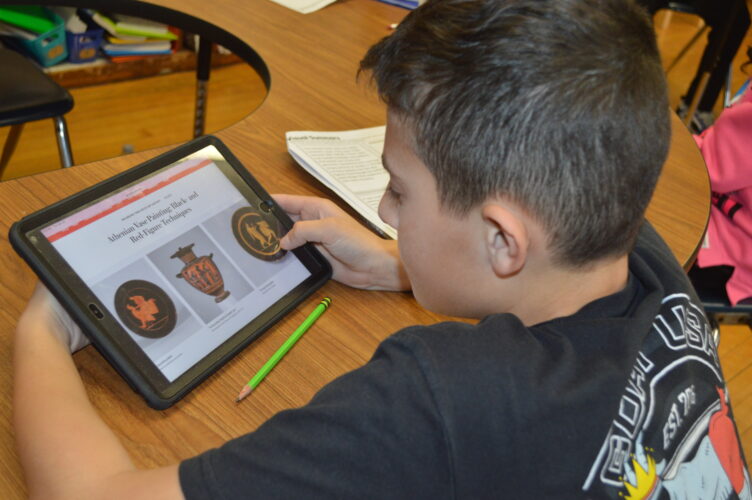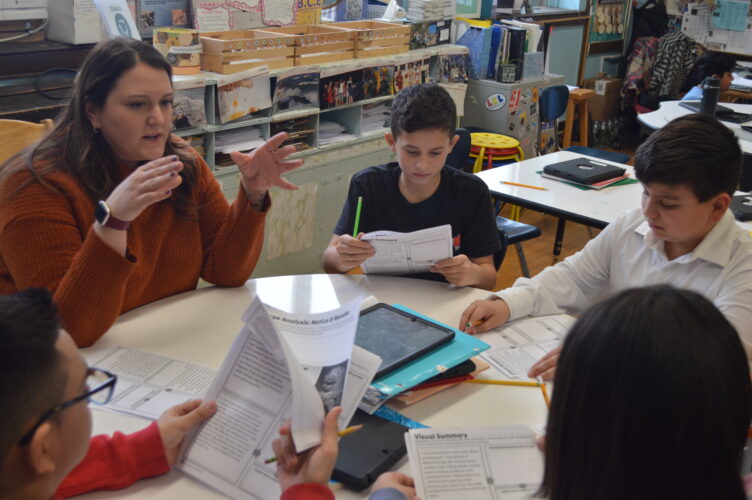Case Study: How 2 Teachers Use AI Behind the Scenes to Build Lessons & Save Time
In a small New York district, 2 6th-grade educators and a librarian are going all in on artificial intelligence. Superintendent hopes others will, too

Get stories like these delivered straight to your inbox. Sign up for The 74 Newsletter
FRANKLIN SQUARE, NEW YORK — The sixth-graders learning about ancient Greek vases in their classroom at John Street School looked like students in nearly any other social studies class in the country. Wearing sweatpants and hoodies, they heard a short lesson about what the vases were used for and how they were decorated before breaking into small groups to ponder specific questions and fill out worksheets.
But behind the scenes, preparing for the lesson was anything but typical for teachers Janice Donaghy and Jean D’Aurio. They had avoided the hours of preparation the lesson might normally have taken by using artificial intelligence to craft a plan that included a summary of ancient Greek vases, exit questions and student activities.
“Classroom preparation goes from hours to seconds” when using AI, said D’Aurio. In the past, the co-teaching pair had created lesson plans by scouring the school’s literacy closet to sift through printed materials, perusing the Teachers Pay Teachers online marketplace and exploring Instagram or TikTok accounts.
For this lesson, the two consulted the county’s curriculum guide but also used Canva, a tool that automatically generated pictures of Grecian vases. The teachers turned to Diffit, another AI application, to craft a reading passage that explained the importance of vases in everyday life in ancient Greece. Diffit also created alternative versions of the text so it would be appropriate for kids reading at different levels, wrote three multiple choice questions to test comprehension and prompted students to draw pictures to show they understood the lesson’s key points. The teachers added short-answer questions that students answered on Google Classroom, and they wrapped up the multi-week lesson by having students paint a design on an actual vase.

“This is just touching the surface of what [AI] has the potential to do,” said Jared Bloom, the superintendent of Franklin Square School District, where both teachers work. “The promise really is to personalize learning, not just differentiate it, in a way that’s not taxing or exhausting for teachers. This could revolutionize education a year from now, as the tools get better and better.”
When ChatGPT was unveiled in late 2022, many educators saw the large language model chatbot as a shortcut students might use to complete — or cheat on — their homework. While it’s still unclear how the technology may ultimately affect schools, growing numbers of teachers are using various AI applications to help cut down on the work they do outside the classroom, from creating lessons to grading papers to emailing parents.
Teachers average about eight to 10 hours a week planning and doing administrative work, said Amanda Bickerstaff, CEO and co-founder of AI for Education, a company that advises districts on how to integrate artificial intelligence into their work. AI is a great way to find efficiencies and lessen that workload, she added.
In Franklin Square, a small K-6 district about 9 miles from John F. Kennedy Airport, the impetus to start using AI came from Bloom. Before the current school year, he highlighted various ways teachers could incorporate AI, from generating ideas for lesson plans to allowing students to use tools to enhance their work. In one example, after students studied houses that are shaped like cats, they created their own drawings. The teacher was then able to use AI tools to show the class how these buildings would look if they were constructed.
D’Aurio said she and Donaghy are “tech nerds” who were the first in their school to experiment with the new technology, and she’s noticed more teachers getting on board “a little at a time.” They use a variety of applications, including Diffit, which can create lesson plans from a few prompts. For instance, teachers can type in “ancient Greek vases” and a grade level, the application takes less than 20 seconds to return an adapted reading passage, a summary, key vocabulary words, and multiple-choice, short-answer and open-ended questions. These elements can be edited and quickly added into activities for students to complete.
Users can also ask the technology to adapt existing text for students reading at different levels. “In one classroom, you could go from second-grade reading level to 10th grade,” Donaghy said.

Other companies help teachers create interactive slideshows, give writing feedback or generate images around various topics.
The inclusion class the pair co-teach contains both general and special education students. Donaghy said AI tools can help her not only create materials that meet students’ individual learning plans, they can track their progress in a variety of areas — a huge time saving because each student can have five or more individual goals.
AI really helped when a new student from El Salvador showed up speaking only Spanish, said Donaghy. The teachers used it to translate every classroom lesson for her, allowing her to understand assignments while she worked in both Spanish and English.
Donaghy said it did take a little trial and error to understand how to best craft queries to get the desired output. But she encourages her peers to try the tools by telling them, “I know tech can be scary, but guys, this is easy.”
While acknowledging that most teachers in the small district haven’t used these tools yet, Bloom said 87% told him at the beginning of this school year that they were interested in trying them out. “They’re intrigued,” he added.
Bickerstaff said about 84% of people who use a smartphone or a computer interact with AI every day, often without realizing it.
John Street School librarian Paige Chambers said she used AI while earning her master’s degree and was eager to see how it could help her at school. Chambers, who teaches media literacy and related lessons to students in her library, said she uses AI tools to help her find ideas for lesson plans. Because results are so quick, she added, it’s easy to modify prompts when they don’t return what she wants.
She has uploaded YouTube videos to AI applications to get a summary of the videos’ contents as well as questions for the students to answer. The tools can also break down a lesson plan into step-by-step directions for her while offering sample projects for students to complete.
Because these tools can add to an existing lesson, Chambers said they can boost an idea she has by filling it out with extra ideas.
Donaghy, D’Aurio and Chambers said they were aware that AI can sometimes hallucinate — make up facts — but reading through what the program creates can help avoid this problem. To stop misinformation, Chambers said she specifically asks these tools to let her know if the application doesn’t have any information about a particular topic. This can prevent them from inventing answers to her prompts.
One area the teachers haven’t used AI for yet is helping to grade student work. This would require teachers to upload students’ writing into AI tools, which could breach the security of student information.
Bloom said he expects technology upgrades to eventually solve this dilemma by creating tools that keep student work from being uploaded to the entire internet. “We’re not trying to remove teachers [from the grading process]. We just want students to get support in the moment. It could be like having a tutor on your shoulder.”
Donaghy said having a tool that checks whether her grading is accurate and fair and hews to a lesson’s rubric would be a big help.
“This is an exciting time for education,” Chambers said. AI “is getting better every day. It’s worlds different in just the half a year I’ve been using it.”
Get stories like these delivered straight to your inbox. Sign up for The 74 Newsletter

